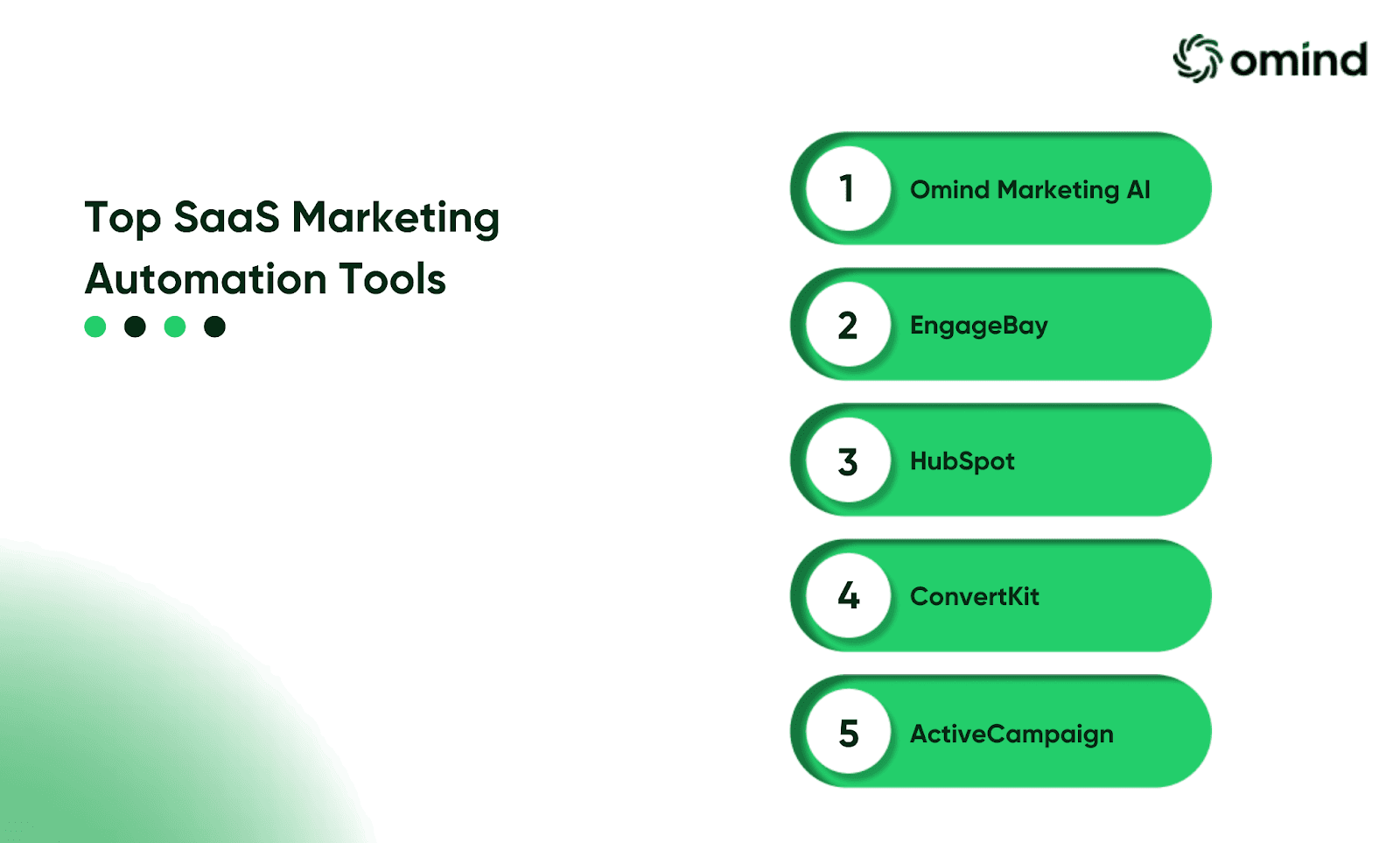A Glimpse into SaaS Marketing Automation
Well, SaaS marketing automation is a must-have tool for businesses. It helps streamline marketing tasks, saves valuable time, and makes it easier to connect with customers on a personal level.
How does it do that?
By automating repetitive tasks, allowing businesses to focus on building strong customer relationships and driving growth.
In this guide, we'll explore the key features that make SaaS marketing automation so powerful, along with its primary objectives.
Common Criteria for Choosing the Right SaaS Marketing Automation Tools
SaaS marketing automation plays a pivotal role in achieving key business objectives, making it easier for companies to enhance their overall customer experience.
Here are a few criteria to consider when selecting the right SaaS marketing automation tool based on your business needs and budget:
Price
SaaS marketing automation tools come with a range of pricing options. Some tools offer tiered pricing based on features or the size of your business, while others might offer customizable plans.
Feature Set
Not all marketing automation tools are created equal, so understanding the features you need is crucial.
Common features to look for include:
Email marketing automation
Customer segmentation
Lead scoring
Analytics
Social media integration.
Advanced tools may offer AI-driven insights, multichannel automation, and personalization options.
Use Cases
Every business has different marketing strategies, so consider how well the tool aligns with your specific use cases.
Whether you're focusing on lead generation, customer retention, or nurturing potential clients, the automation platform should offer tailored solutions for these goals.
Scalability
Consider how well the tool can scale up as your business expands, accommodating a larger customer base and more complex marketing efforts without compromising performance.
Imagine you’re a small e-commerce business using a basic marketing tool that fits your needs for now. However, as your customer base grows, you need more advanced features like behavioral tracking and multi-channel campaign management.
Ease of Use
The tool should be intuitive and easy to navigate for your team.
A steep learning curve can slow down adoption, reducing the efficiency you're aiming for. Look for user-friendly interfaces, clear documentation, and readily available customer support to ensure smooth onboarding and everyday use.
Integration Capabilities
Your marketing automation tool should integrate seamlessly with your existing software stack, including:
CRM
Email marketing platforms
Analytics tools
Social media channels.
The more seamless the integrations, the easier it is to create a unified marketing system that works efficiently across different departments.
Read this too: Best Practices for Integrating Marketing Automation Tools
Customer Support and Training
Don’t overlook the importance of reliable customer support and ongoing training resources.
Whether it’s troubleshooting technical issues or learning to use advanced features, having a responsive support team and access to training materials can make a huge difference.
Customization and Flexibility
Every business has unique processes, so the ability to customize workflows, dashboards, and reports to fit your specific needs is crucial.
A tool that offers flexibility in adjusting campaigns, workflows, and data analysis will give your team more control over marketing operations.
Data Security and Compliance
Depending on your industry, compliance with regulations like GDPR or HIPAA might be essential.
Make sure the platform you choose offers strong data security features and is compliant with relevant data protection laws, ensuring your customers' information is safe.
ROI and Long-Term Value
Beyond just the initial price tag, assess how quickly you can see a return on investment (ROI) from the tool. A tool that may seem cost-effective initially but lacks key features or scalability could end up costing more in the long run.
So, balance immediate budget constraints with the tool’s long-term value to your business growth.
Take Omind’s Marketing AI for instance. The tool maximizes customer retention by understanding why customers disengage. It fine-tunes onboarding and engagement tactics with AI for higher lifetime value.
By considering these factors, you'll be in a much better position to select the right marketing automation tool tailored to your business needs and budget.
Objectives of SaaS Marketing Automation Tools
One key goal?
Improving the in-app experience. By delivering personalized content and timely notifications, automation ensures users stay engaged and satisfied without you having to lift a finger constantly.
And what about email marketing?
It’s a breeze with automation. You can create targeted, data-driven campaigns that connect with customers on a personal level—minus the endless manual effort.
It doesn’t stop there. Automation helps you extend your social media reach too.
Scheduling posts, ensuring consistent messaging, and analyzing your interactions across platforms become so much easier. This way, you can stay relevant without being stuck behind a screen all day.
Plus, with all that customer data, you can leverage it to better understand your audience. From personalized recommendations to special offers, you can make your customers feel seen and valued.
Finally, automation streamlines your workflows including
Taking care of repetitive tasks
Reducing manual errors
Freeing up your team to focus on more strategic projects.
So, in a nutshell, SaaS marketing automation boosts efficiency while keeping everything personal and engaging.
Also Read: 6 Popular Email Automation Examples for Marketing Campaigns
5 Top SaaS Marketing Automation Tools You Must Try
Whether you're just starting or already running an established business, these SaaS marketing automation platforms will help you streamline your processes and enhance customer engagement.
Each caters to different business sizes and goals, ensuring there’s a perfect fit for everyone.
Here's the detailed breakdown of the top tools:

1. Omind Marketing AI
Unlock the full potential of every automated campaign with Omind Marketing AI. Our tool uses AI to help you refine customer journeys and predict actions for better outcomes.
Let’s dive deep into this feature-packed tool!
Journey Orchestration:
Easily map and optimize each step of the customer journey with intuitive tools, creating seamless, personalized experiences that drive satisfaction and engagement.
User Segmentation:
Segment your audience based on behavior, preferences, and demographics to deliver highly targeted marketing strategies that resonate with the right people at the right time.
Manage communications across multiple channels—WhatsApp, email, SMS, social media—from one platform, ensuring consistent messaging and maximizing reach.
Hyper-Personalization:
Use AI and machine learning to tailor content, offers, and interactions for each customer, enhancing loyalty and conversions with uniquely relevant experiences.
Recommendations:
Leverage AI-powered recommendation engines to suggest products or content that align with customer interests, boosting sales and satisfaction with personalized suggestions.
2. EngageBay
If you’re looking for an all-in-one platform that handles CRM, email personalization, and marketing analytics, EngageBay is a great choice.
It even includes live chat, making it a well-rounded tool for businesses that want to manage customer interactions from one place.
Whether you’re just starting out or ready to scale, EngageBay offers a range of plans to suit your needs across all aspects of customer engagement.
3. HubSpot
HubSpot is a name that needs no introduction in the marketing world.
It’s much more than just automation—it’s a powerhouse that covers everything from SEO to social media management, all seamlessly integrated with their CRM.
So, whether you're building your website or managing social media campaigns, HubSpot’s got your back. They also offer flexible plans to cater to different business sizes:
Starter Plan: Great for small businesses, providing essential tools to kickstart your marketing efforts.
Professional Plan: A robust package designed for growing companies looking to dive deeper into automation, SEO, and analytics.
Enterprise Plan: Geared towards large enterprises, offering advanced features like custom reporting, AI, and team collaboration.
4. ConvertKit
If email marketing is at the heart of your strategy, ConvertKit has you covered.
It’s built with creators in mind, making audience engagement and email marketing automation a breeze.
You can set up email funnels in no time and track how well your campaigns are doing, all from one easy-to-use platform.
ConvertKit offers plans tailored to creators at every stage:
Free Plan: Ideal for those starting out, allowing you to grow your audience and send your first campaigns without paying a cent.
Creator Plan: This plan is designed for growing businesses and creators who need more control over their email automation.
Creator Pro Plan: For professionals who need the full range of features, offering advanced analytics and optimization tools.
5. ActiveCampaign
ActiveCampaign is known for its sophisticated email sequences and contact segmentation.
This tool automates your customer engagement while offering a personal touch. Its automated triggers make it easy to send the right message to the right person at the perfect time, without lifting a finger.
Lite Plan: A cost-effective option with essential tools for businesses just getting started with automation.
Pro Plan: Packed with advanced features for companies that need more complex automation workflows and deeper contact management.
You might find this relevant: Top Mobile Marketing Automation Platforms in 2024: A Comprehensive Guide
Stay tuned for insights that can transform your marketing efforts!
Marketing Automation Strategies for SaaS Companies
The below mentioned strategies, when implemented thoughtfully, can transform how you manage marketing automation for your SaaS company.

Eject Converted Users
Once a user has converted, there’s no need to keep them in your lead-nurturing workflows. Segmenting your audience based on their actions is key here.
For example, once a user completes a purchase, they can automatically be moved into a retargeting or post-purchase email campaign.
And here’s a pro tip: Setting up real-time automation ensures you’re acting on conversions instantly, keeping your strategy sharp and up to date.
Be Clear with Naming Conventions
When it comes to your lead generation, having a solid naming structure across your company helps avoid confusion and keeps everyone on the same page.
Imagine having a company-wide dictionary or knowledge base where all your teams can refer to the same terms. It simplifies collaboration and makes reporting much easier down the road.
Integrate Your Marketing Automation Tools
Smooth integrations between your marketing automation tools are non-negotiable.
When your tools work together, you get better data insights and can create workflows that adapt to customer behavior.
Don’t Forget Your Churned Users
Churned users aren’t gone forever, so don’t leave them behind!
Set up automation to re-engage these users with personalized sequences aimed at bringing them back.
Adding churn surveys into your CRM can help you understand why users left in the first place and inform future strategies to win them back.
Build Out Email Marketing Functions
is still one of the most powerful tools for SaaS companies, especially for lead generation.
By building targeted email nurture flows, you can guide leads through the customer journey, providing relevant content at each stage.
Pro tip: Ensure these email flows are nurturing leads until they’re ready to convert and even beyond.
For more information about email marketing, read our blog on: How to Choose and Implement Your Email Marketing Platform Tools
Make the Most of Your Data
Your marketing automation is only as good as the data you feed into it.
The more data you gather, the better you can personalize and optimize your campaigns.
Whether through attribution models or manual data analysis, having clear insights allows you to align your strategies with real customer behavior.
For example, tracking which campaigns are driving the most conversions helps you focus your efforts on what’s working best.
Build a Multi-Touchpoint Attribution Strategy
Multi-touchpoint attribution helps you understand the various touchpoints that contribute to a lead’s conversion.
To map out customer journeys effectively, it requires:
A robust tech stack
Clear audience lists
Well-defined personas.
Note: While lead scoring is a great way to prioritize your prospects, be cautious not to assign too much weight to a single interaction.
The Bottom Line
Implementing these strategies will enhance your marketing efforts and create stronger connections with your audience. A balanced approach helps you accurately assess how each touchpoint influences the overall SaaS marketing journey.
Looking for a powerful tool to elevate your marketing game?
AUTHOR
Team Omind
Empowering Businesses with Unified Customer Experience Platform, Leveraging Advanced AI and Intelligent Automation
PRODUCT
Marketing AI
Share LINK
Related Blogs




